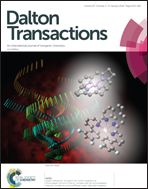Slow relaxation of magnetization in a bis-mer-tridentate octahedral Co(ii) complex†
Abstract
Reaction of a rigid tridentate ligand o-[(1H-imidazol-2-yl)methylideneamino]phenol (2-H2imap) with Co(ClO4)2 in the presence of NaN3, or Co(NO3)2 without a base yields [CoII(2-Himap)2] 1 and [CoIII(2-Himap)2]NO3·MeOH 2, respectively. Both complexes exhibit a mer-octahedral geometry with the cobalt centre being distorted along an octahedral-trigonal prismatic pathway. The packing in 1 and 2 is dominated by H-bonding forming 2D sheets and 1D chains, respectively. Detailed dc and ac magnetic studies indicate that 1 is a field-induced single-ion magnet (SIM) with D = 36.7 cm−1 and E = 2.0 cm−1. Extensive ab initio calculations support these conclusions and suggest that relaxation of the magnetization occurs principally through direct quantum tunnelling in the ground state, with the Raman process dominant in an applied field. This contrasts with the recently reported series of mer-[Co(L)2] (L = monoanionic NNO donor ligand; Inorg. Chem., 2017, 56, 6056–6066) complexes where D is negative, as these compounds have a more ambiguous geometry, and highlights the importance of supramolecular interactions in subtly altering the coordination sphere thereby impacting the magnetic behaviour.



 Please wait while we load your content...
Please wait while we load your content...